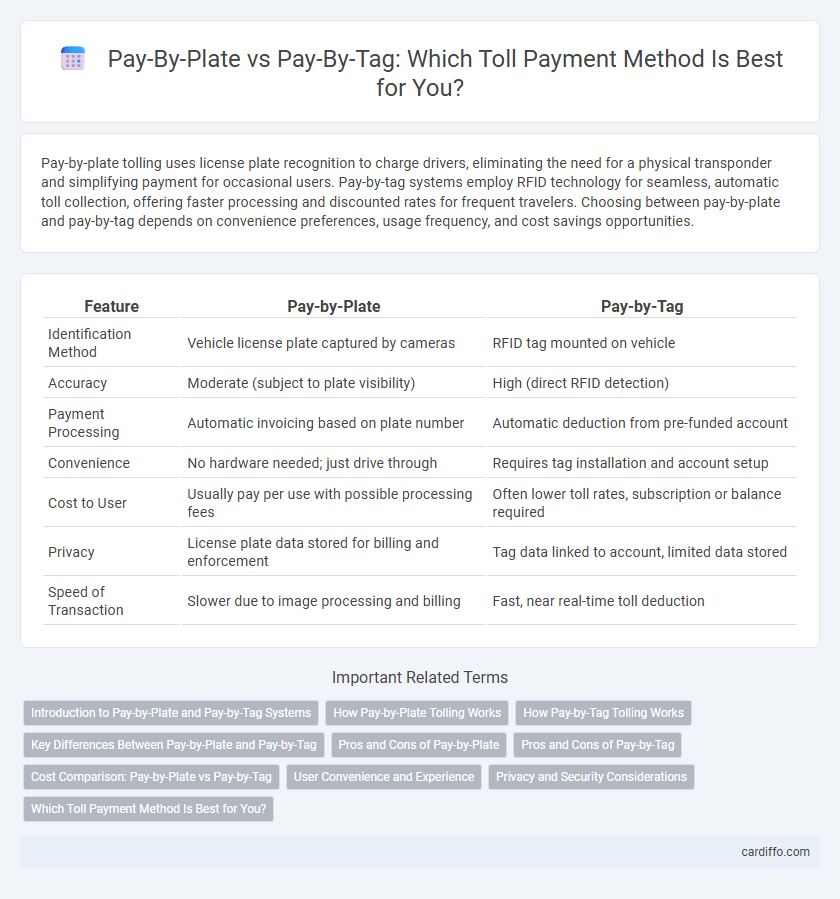Pay-by-plate tolling uses license plate recognition to charge drivers, eliminating the need for a physical transponder and simplifying payment for occasional users. Pay-by-tag systems employ RFID technology for seamless, automatic toll collection, offering faster processing and discounted rates for frequent travelers. Choosing between pay-by-plate and pay-by-tag depends on convenience preferences, usage frequency, and cost savings opportunities.
Table of Comparison
| Feature | Pay-by-Plate | Pay-by-Tag |
|---|---|---|
| Identification Method | Vehicle license plate captured by cameras | RFID tag mounted on vehicle |
| Accuracy | Moderate (subject to plate visibility) | High (direct RFID detection) |
| Payment Processing | Automatic invoicing based on plate number | Automatic deduction from pre-funded account |
| Convenience | No hardware needed; just drive through | Requires tag installation and account setup |
| Cost to User | Usually pay per use with possible processing fees | Often lower toll rates, subscription or balance required |
| Privacy | License plate data stored for billing and enforcement | Tag data linked to account, limited data stored |
| Speed of Transaction | Slower due to image processing and billing | Fast, near real-time toll deduction |
Introduction to Pay-by-Plate and Pay-by-Tag Systems
Pay-by-Plate systems utilize automatic license plate recognition technology to identify vehicles and charge tolls based on the registered plate, eliminating the need for physical transponders. In contrast, Pay-by-Tag relies on RFID-enabled tags affixed to vehicles, allowing for faster and more seamless toll transactions through dedicated tag readers. Both methods offer electronic toll collection solutions, but Pay-by-Plate provides greater accessibility for occasional users, while Pay-by-Tag emphasizes convenience for frequent travelers.
How Pay-by-Plate Tolling Works
Pay-by-plate tolling uses automatic license plate recognition (ALPR) technology to capture vehicle plates via roadside cameras as vehicles pass through toll points, enabling seamless fee processing without the need for in-car devices. This system links plate data to the registered vehicle owner, who receives a bill by mail or email, ensuring toll collection even for drivers without prepaid tags. Pay-by-plate tolling enhances accessibility across varying vehicle types and traveler preferences while maintaining efficient revenue collection for toll agencies.
How Pay-by-Tag Tolling Works
Pay-by-tag tolling operates through RFID technology embedded in a small electronic tag affixed to a vehicle's windshield, enabling automatic identification at toll plazas. As the vehicle passes a toll point, the tag transmits a signal to sensors, facilitating seamless toll deduction from a prepaid account without requiring the driver to stop. This method enhances traffic flow efficiency and reduces congestion compared to manual toll collection or pay-by-plate systems while providing accurate usage tracking.
Key Differences Between Pay-by-Plate and Pay-by-Tag
Pay-by-plate systems utilize automatic license plate recognition to charge tolls, eliminating the need for physical devices but sometimes causing delays due to image processing errors. Pay-by-tag employs RFID transponders that communicate directly with toll readers, allowing faster, more accurate toll transactions and often discounted rates. Key differences include installation requirements, transaction speed, error rates, and cost savings, with pay-by-tag generally preferred for frequent travelers seeking convenience and lower fees.
Pros and Cons of Pay-by-Plate
Pay-by-plate tolling offers convenience by eliminating the need for physical tags, allowing drivers to pass through tolls without additional equipment. However, it can result in higher processing fees and potential billing delays due to license plate recognition errors. This system is ideal for occasional users but may incur additional costs compared to pay-by-tag options designed for frequent commuters.
Pros and Cons of Pay-by-Tag
Pay-by-tag offers seamless toll payments by automatically charging vehicles through RFID technology, reducing delays and eliminating the need for manual transactions. However, it requires upfront tag registration and installation, which may pose privacy concerns for some users due to continuous tracking. Maintenance and potential tag malfunctions can lead to billing errors, requiring vigilant account monitoring to avoid discrepancies.
Cost Comparison: Pay-by-Plate vs Pay-by-Tag
Pay-by-plate systems typically incur higher operational costs due to the need for advanced license plate recognition technology and manual invoice processing, resulting in increased administrative fees for users. In contrast, pay-by-tag systems leverage RFID technology, enabling automated toll collection and lower transaction fees, which often translates to more cost-effective toll payments for frequent drivers. Evaluating the long-term expenses, pay-by-tag offers better value with reduced per-trip costs and fewer billing delays compared to pay-by-plate.
User Convenience and Experience
Pay-by-plate systems enhance user convenience by eliminating the need for physical tags and enabling automatic license plate recognition, allowing seamless toll payments without prior registration. Pay-by-tag offers faster transaction speeds at toll booths due to dedicated lanes but requires users to obtain and maintain a physical transponder. Users prioritize pay-by-plate for hassle-free accessibility across multiple vehicles, while pay-by-tag appeals to frequent commuters seeking immediate and consistent toll processing.
Privacy and Security Considerations
Pay-by-plate systems capture and store vehicle license plate images, raising concerns about data privacy and potential unauthorized access to personal information. Pay-by-tag uses RFID technology that limits data exposure to registered tag signals, enhancing security by reducing the risk of license plate cloning or image interception. Both methods require robust encryption and strict access controls to safeguard user data and ensure compliance with privacy regulations.
Which Toll Payment Method Is Best for You?
Pay-by-tag offers seamless passage through toll booths using RFID technology, minimizing delays and often reducing toll rates through discounted programs. Pay-by-plate requires users to pay tolls based on license plate recognition, which can incur higher fees and occasional processing delays due to image verification. Choosing the best toll payment method depends on your travel frequency, budget, and preference for convenience versus cost-effectiveness.
Pay-by-plate vs pay-by-tag Infographic

 cardiffo.com
cardiffo.com